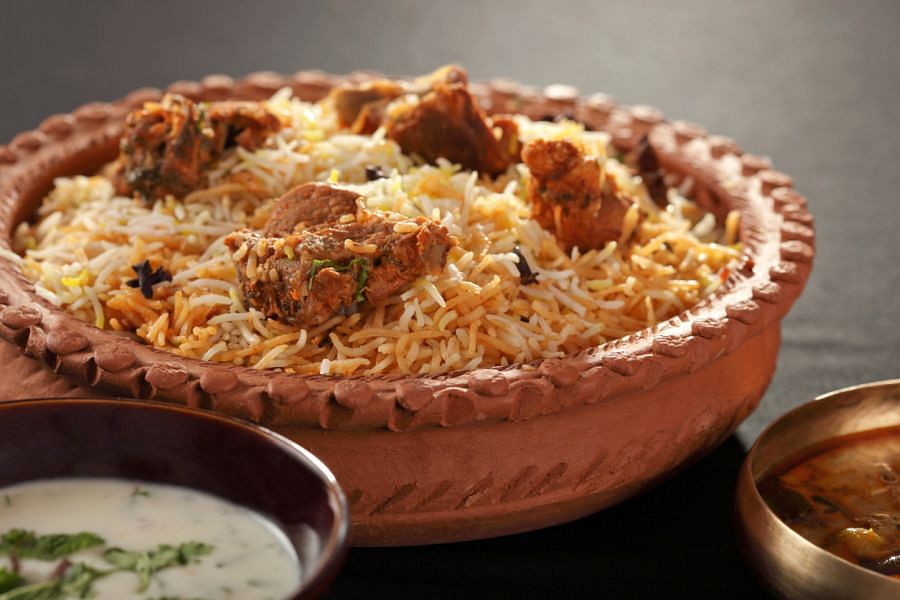
A mention of biryani (or biriyani) is enough to make one’s mouth water and feel hungry. And when it is in front of you steaming and smelling nice, the tendency is to launch a vicious attack and devour it. That is how much we love biryani.
Biryani is not something that can be whipped up in a trice. There is a very precise and long process of making it to get the best tasting product, not just for the most popular Hyderabadi biryani but the others too. When prepared well, it is nothing short of a work of art. When layers of the freshly cooked biryani are gently mixed together, the intertwining of the white and coloured grains of rice along with the pieces of meat or vegetable is a sight to behold.
Biryani is a meal in itself. There are several variations of this popular dish apart from the Hyderabadi. There are the Awadhi (or Lucknowi), Kolkata, Ambur, Dindigul, Thalassery, Donne, Bhatkali and many more.
Biryani is largely cooked in the dum pukht style, which means cooking in a sealed degchi or handi (vessels used to make biryani). For example, the traditionally prepared Hyderabadi biryani has partially cooked rice being added as a layer over the bottom layer of meat that has been cooked in spices. Once the fried onions and saffron are added on the top layer, the opening is closed with a lid and sealed with dough. This forms an airtight seal and lets the biryani cook slowly. The idea of the seal is to trap the aroma of the spices inside and let the rice and meat absorb it.
In the dum pukht way of making biryani, not much water is added. It is the steam that does the cooking in a degchi, which is a vessel that has sloping sides. The steam rises from the bottom and does the cooking. The steam condenses when it hits the lid and water droplets come back to the bottom of the vessel. This process repeats and the result is aromatic biryani.
Of course, for those who do not eat meat, vegetable biryani has become the rage. However, a lot of people consider that biryani is biryani only if cooked with meat. Vegetarian biryani is considered pulao by non-vegetarians. However, it is not as simple as that, and the difference appears to be very small going by history.
In food historian KT Achaya’s book ‘A Historical Dictionary of Indian Food’, biryani is described as: “A spicy dish of meat cooked with rice, referred to by this term in the thirteenth century. Numerous variations occur all over India. One is the kacchi-biriyani of Hyderabad, with the meat very soft and almost disintegrating into the rice, and irregular patches of yellow saffron colouring.
“A palao (q.v.) is very similar, and the word itself is of older usage in India. Recipes in the Ain-i-Akbari show little distinction between the biriyani and palao.”
In the same book, palao is described as: “A dish of rice cooked with spiced meat and ghee. The word is ascribed to the Persian and Arabic pilav, pulao and pallao, yet it would appear to have found its way long ago into both Sanskrit (in the Yagnavalkya Smriti as pallao-mevach) and early Tamil literature of the third to the sixth centuries AD. Biriyani (q.v.) is quite similar to palao, to the word being derived from the Persian term birinj for rice.
“A chicken palao was noted at the Sultanate court in Delhi in the thirteenth century. The multi-coloured navratan palao with saffron, sultanas, paneer and nuts, was designed to honour the nine intellectual gems of Akbar’s court.”
Whether vegetable biryani is biryani or pulao is a subject for debate that will go on for a long time. And so will the debate about which variety of biryani is the best.
The popularity of biryani has increased manifold and this dish turned out to be the most ordered on food delivery apps according to a report published at the end of last year. However, ask a mature food lover and he or she will tell you that all biryanis are not the same. For example, if it is from Bengaluru’s Shivaji Military Hotel and New Govind Military Hotel, Hyderabad’s Paradise Biryani or such other eateries that have been around for a very long time, the diner can be assured that good ingredients have been used and in the right proportion too. The result will be a well-made and tasty product.
Biryani’s popularity has led to a lot of restaurants serving this dish. This brings up the question as to how many will provide food that is actually well prepared and with quality ingredients. Quite often, the newer eateries make it rich and with a ton of masala. This might tickle the taste buds, but well-made biryani will always stand out.